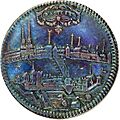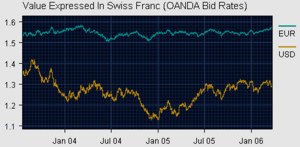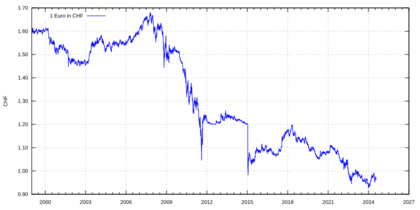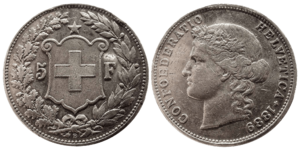Swiss franc facts for kids
Quick facts for kids Swiss franc |
|||||
|---|---|---|---|---|---|
|
|||||
| ISO 4217 Code | CHF | ||||
| Official user(s) | |||||
| Unofficial user(s) | |||||
| Inflation | 2.1% in 2023 | ||||
| Source | Statistik Schweiz | ||||
| Subunit | |||||
| 1⁄100 | |||||
| Nickname |
Füfräppler for a 5 centimes coin; Zëhräppler for a 10 centimes coin; Zwänzgräppler for a 20 centimes coin; Stutz or Franke for a 1 franc coin or change in general; Füüfliiber for a 5 francs coin; Rappe and Batze are specifically used for coin below 1 franc, but also figuratively for change in general
|
||||
| Plural | |||||
| Coins | |||||
| Freq. used | 5, 10, 20 Centimes, 1⁄2, 1, 2, 5 Francs | ||||
| Banknotes | |||||
| Freq. used | 10, 20, 50, 100, 200, 1000 Francs | ||||
| Printer | Orell Füssli | ||||
The Swiss franc is the money used in Switzerland and Liechtenstein. It is also accepted in Campione d'Italia, a small part of Italy surrounded by Switzerland. The Swiss National Bank makes the banknotes (paper money), and Swissmint makes the coins.
The Swiss franc is often called Fr. in German, and fr. in French, Italian, and Romansh. You might also see it as CHF, which stands for Confoederatio Helvetica Franc. This is a Latin name for Switzerland. Banks and financial groups use CHF as its official code.
A franc is divided into 100 smaller parts. These are called Rappen in German, centime in French, centesimo in Italian, and rap in Romansh.
Contents
History of the Swiss Franc
Early Money in Switzerland
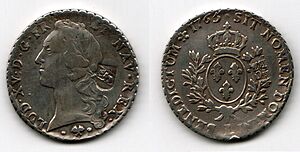
Before 1798, many different groups in Switzerland made their own coins. There were about 75 different places making money, including 25 cantons (like states) and cities. This meant there were around 860 different coins! It was very confusing because each coin had a different value. Most of these coins were based on the French livre or the German gulden.
People mostly used foreign coins like French francs because they were accepted everywhere. Local Swiss coins were often only good in one canton.
The First Swiss Franc (1798–1847)
In 1798, a new government called the Helvetic Republic created the first unified Swiss franc. It was based on the Bern livre and was divided into 10 batzen or 100 rappen (centimes). This franc was used until 1803.
After 1815, Switzerland tried to make its money system simpler again. But by 1820, there were still 8,000 different coins in use! In 1825, some cantons agreed to make similar coins called Konkordanzbatzen. These coins had the canton's symbol but were worth the same everywhere.
The Modern Swiss Franc (1850–Present)
The old system with many different coins was still a problem. In 1848, Switzerland's new constitution said that only the federal government could make money. Two years later, in 1850, the modern Swiss franc was officially created.
The new Swiss franc was made to be worth the same as the French franc. In 1865, Switzerland joined the Latin Monetary Union with France, Belgium, and Italy. They all agreed to make their money worth the same amount of silver or gold.
The Swiss franc has often been seen as a "safe" currency. This means people trust it, especially during uncertain times. For a long time, Swiss law said that at least 40% of the franc's value had to be backed by gold. But this rule ended in 2000. Now, the franc is fiat money, meaning its value comes from trust in the government, not from being backed by gold.
Big Changes: 2011–2015
Around 2011, the Swiss franc became very strong. This happened because of money problems in other parts of Europe. Many people wanted to put their money in Switzerland because it felt safer. This made Swiss products more expensive for other countries to buy.
To help its economy, the Swiss National Bank decided in September 2011 to set a minimum exchange rate for the franc against the euro. This meant that one euro would always be worth at least 1.20 Swiss francs. The bank said it would buy as much foreign money as needed to keep this rate. This was a big surprise to many people.
However, on January 15, 2015, the Swiss National Bank suddenly removed this minimum exchange rate. This caused the franc to become much stronger very quickly, especially against the euro. It was a huge shock to financial markets and caused some currency traders to lose a lot of money.
Swiss Coins
Coins of the Swiss Confederation
In 1850, Switzerland started making new coins. These included 1, 2, 5, 10, and 20 centimes, and 1⁄2, 1, 2, and 5 francs. The smaller coins were made of bronze or a mix of metals. The franc coins were made of silver.
Over the years, the materials used for coins changed. For example, nickel replaced other metals in some coins. Gold coins were also made, called Vreneli, but they stopped being used in 1936.
During the world wars, some coins were temporarily made from brass and zinc. In the 1960s, silver coins became worth more as metal than as money, so people started melting them down. The government tried to stop this.
The 1 centime coin was made until 2006 but was not used much. It was officially removed from circulation in 2007. The 2 centime coin was removed even earlier, in 1978.
The designs of Swiss coins have not changed much since 1879. One interesting change happened in 1983. The 1 franc coin, which shows a ring of stars, changed from 22 stars to 23. This was because Jura became the 23rd canton of Switzerland in 1979.
The 10 centime coins made since 1879 (with a few exceptions) have the same size, material, and design as today. They are still valid money and can be found in circulation. This makes it one of the oldest original currencies still used in the world!
Swiss coins do not use any of Switzerland's four national languages. Instead, they use numbers, the abbreviation "Fr." for franc, and Latin words like Helvetia or Confœderatio Helvetica. This makes them neutral for all language speakers.
| Value | Diameter (mm) |
Thickness (mm) |
Mass (g) |
Composition | Remarks |
|---|---|---|---|---|---|
| 5 centimes | 17.15 | 1.25 | 1.8 | Aluminium bronze | Made in cupronickel or pure nickel until 1980 |
| 10 centimes | 19.15 | 1.45 | 3 | Cupronickel | Made in current minting since 1879 |
| 20 centimes | 21.05 | 1.65 | 4 | Cupronickel | |
| 1⁄2 franc | 18.20 | 1.25 | 2.2 | Cupronickel | In silver until 1967 |
| 1 franc | 23.20 | 1.55 | 4.4 | Cupronickel | In silver until 1967 |
| 2 francs | 27.40 | 2.15 | 8.8 | Cupronickel | In silver until 1967 |
| 5 francs | 31.45 | 2.35 | 13.2 | Cupronickel | In silver until 1967 and in 1969; 25 g mass until 1930 |
Swiss Banknotes
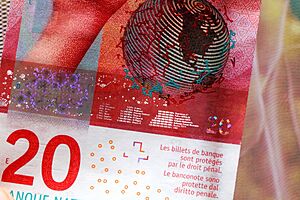
The Swiss National Bank started printing banknotes in 1907. They made notes for 50, 100, 500, and 1000 francs. Later, 20-franc and 5-franc notes were added. In 1952, the 5-franc notes were stopped, and 10-franc notes were introduced in 1955. In 1996, a new 200-franc note was introduced, and the 500-franc note was stopped.
The Swiss National Bank has printed nine different series of banknotes. Seven of these have been used by the public. The fourth and seventh series were kept as "reserve series" in case of widespread fake money.
The sixth series of banknotes, from 1976, showed famous scientists. These notes are no longer valid money since 2000. However, you can still exchange them for new notes at the Swiss National Bank. This rule used to have a time limit, but now you can exchange them at any time.
The eighth series of banknotes came out starting in 1995. These notes had a new vertical design and featured different artists. The 500-franc note was replaced by a 200-franc note, which became more popular. The colors of the notes were similar to the old ones, but the 20-franc note changed from blue to red to avoid confusion with the 100-franc note. The notes also had many new security features to prevent faking.
| Image | Value | Dimensions | Main colour | Obverse | Date of issue | Date of withdrawal | Remarks | |
|---|---|---|---|---|---|---|---|---|
| Obverse | Reverse | |||||||
 |
 |
10 francs | 126 × 74 mm | Yellow | Le Corbusier | 8 April 1995 | 30 April 2021 | |
 |
 |
20 francs | 137 × 74 mm | Red | Arthur Honegger | 1 October 1994 | 30 April 2021 | |
 |
 |
50 francs | 148 × 74 mm | Green | Sophie Taeuber-Arp | 3 October 1995 | 30 April 2021 | |
 |
 |
100 francs | 159 × 74 mm | Blue | Alberto Giacometti | 1 October 1998 | 30 April 2021 | |
 |
 |
200 francs | 170 × 74 mm | Brown | Charles-Ferdinand Ramuz | 1 October 1997 | 30 April 2021 | Replaced the 500-franc banknote in the previous series |
 |
 |
1000 francs | 181 × 74 mm | Purple | Jacob Burckhardt | 1 April 1998 | 30 April 2021 | |
| These images are to scale at 0.7 pixel per millimetre. For table standards, see the banknote specification table. | ||||||||
All Swiss banknotes use all four national languages. The side with a German-speaking person has German and Romansh. The side with a French or Italian-speaking person has French and Italian. The other two languages are on the back.
The ninth series of banknotes started being released in 2016. The first was the 50-franc note. These new notes have themes like "Switzerland's organizational talent" (10 francs), "creativity" (20 francs), "wealth of experiences" (50 francs), "humanitarian tradition" (100 francs), "scientific expertise" (200 francs), and "communicative flair" (1000 francs).
All banknotes from the eighth series were removed from circulation on April 30, 2021. However, like the sixth series, they can still be exchanged for new notes at the Swiss National Bank at any time.
| 9th (current) series of Swiss banknotes | |||||||||
|---|---|---|---|---|---|---|---|---|---|
| Image | Value | Dimensions | Main colour | Theme (a typically Swiss characteristic) |
Obverse (an action) |
Reverse (a Swiss location and an object) |
Date of issue | ||
| Obverse | Reverse | ||||||||
 |
 |
10 francs | 70 × 123 mm | Yellow | Switzerland's organisational talent Key motif: Time |
|
|
18 October 2017 | |
 |
 |
20 francs | 70 × 130 mm | Red | Switzerland's creativity Key motif: Light |
|
|
17 May 2017 | |
 |
 |
50 francs | 70 × 137 mm | Green | Wealth of experiences Switzerland offers Key motif: Wind |
|
|
12 April 2016 | |
 |
 |
100 francs | 70 × 144 mm | Blue | Switzerland's humanitarian tradition Key motif: Water |
|
12 September 2019 | ||
 |
 |
200 francs | 70 × 151 mm | Brown | Switzerland's scientific expertise Key motif: Matter |
|
|
22 August 2018 | |
 |
 |
1000 francs | 70 × 158 mm | Purple | Switzerland's communicative flair Key motif: Language |
|
|
13 March 2019 | |
| For table standards, see the banknote specification table. | |||||||||
Where the Swiss Franc is Used
| Rank | Currency | ISO 4217 code (symbol) |
% daily share (April 2016) |
|||||||||||||||||||||||||||||||||||||||||||||||||||||||||||||||||||||||||||||||||||||||||||||||||||||||||||||||||||||||||||||||||||||||||||||||||||||||||||||||||||||||||||||||||||||||||||||||||||||||||||||||||||||||||||||||||||
|---|---|---|---|---|---|---|---|---|---|---|---|---|---|---|---|---|---|---|---|---|---|---|---|---|---|---|---|---|---|---|---|---|---|---|---|---|---|---|---|---|---|---|---|---|---|---|---|---|---|---|---|---|---|---|---|---|---|---|---|---|---|---|---|---|---|---|---|---|---|---|---|---|---|---|---|---|---|---|---|---|---|---|---|---|---|---|---|---|---|---|---|---|---|---|---|---|---|---|---|---|---|---|---|---|---|---|---|---|---|---|---|---|---|---|---|---|---|---|---|---|---|---|---|---|---|---|---|---|---|---|---|---|---|---|---|---|---|---|---|---|---|---|---|---|---|---|---|---|---|---|---|---|---|---|---|---|---|---|---|---|---|---|---|---|---|---|---|---|---|---|---|---|---|---|---|---|---|---|---|---|---|---|---|---|---|---|---|---|---|---|---|---|---|---|---|---|---|---|---|---|---|---|---|---|---|---|---|---|---|---|---|---|---|---|---|---|---|---|---|---|---|---|---|---|---|---|---|---|---|---|
|
|
|
87.6% | ||||||||||||||||||||||||||||||||||||||||||||||||||||||||||||||||||||||||||||||||||||||||||||||||||||||||||||||||||||||||||||||||||||||||||||||||||||||||||||||||||||||||||||||||||||||||||||||||||||||||||||||||||||||||||||||||||||
|
|
|
31.4% | ||||||||||||||||||||||||||||||||||||||||||||||||||||||||||||||||||||||||||||||||||||||||||||||||||||||||||||||||||||||||||||||||||||||||||||||||||||||||||||||||||||||||||||||||||||||||||||||||||||||||||||||||||||||||||||||||||||
|
|
|
21.6% | ||||||||||||||||||||||||||||||||||||||||||||||||||||||||||||||||||||||||||||||||||||||||||||||||||||||||||||||||||||||||||||||||||||||||||||||||||||||||||||||||||||||||||||||||||||||||||||||||||||||||||||||||||||||||||||||||||||
|
|
|
12.8% | ||||||||||||||||||||||||||||||||||||||||||||||||||||||||||||||||||||||||||||||||||||||||||||||||||||||||||||||||||||||||||||||||||||||||||||||||||||||||||||||||||||||||||||||||||||||||||||||||||||||||||||||||||||||||||||||||||||
|
|
|
6.9% | ||||||||||||||||||||||||||||||||||||||||||||||||||||||||||||||||||||||||||||||||||||||||||||||||||||||||||||||||||||||||||||||||||||||||||||||||||||||||||||||||||||||||||||||||||||||||||||||||||||||||||||||||||||||||||||||||||||
|
|
|
5.1% | ||||||||||||||||||||||||||||||||||||||||||||||||||||||||||||||||||||||||||||||||||||||||||||||||||||||||||||||||||||||||||||||||||||||||||||||||||||||||||||||||||||||||||||||||||||||||||||||||||||||||||||||||||||||||||||||||||||
|
|
|
4.8% | ||||||||||||||||||||||||||||||||||||||||||||||||||||||||||||||||||||||||||||||||||||||||||||||||||||||||||||||||||||||||||||||||||||||||||||||||||||||||||||||||||||||||||||||||||||||||||||||||||||||||||||||||||||||||||||||||||||
|
|
|
4.0% | ||||||||||||||||||||||||||||||||||||||||||||||||||||||||||||||||||||||||||||||||||||||||||||||||||||||||||||||||||||||||||||||||||||||||||||||||||||||||||||||||||||||||||||||||||||||||||||||||||||||||||||||||||||||||||||||||||||
|
|
|
2.2% | ||||||||||||||||||||||||||||||||||||||||||||||||||||||||||||||||||||||||||||||||||||||||||||||||||||||||||||||||||||||||||||||||||||||||||||||||||||||||||||||||||||||||||||||||||||||||||||||||||||||||||||||||||||||||||||||||||||
|
|
|
2.1% | ||||||||||||||||||||||||||||||||||||||||||||||||||||||||||||||||||||||||||||||||||||||||||||||||||||||||||||||||||||||||||||||||||||||||||||||||||||||||||||||||||||||||||||||||||||||||||||||||||||||||||||||||||||||||||||||||||||
|
|
|
1.9% | ||||||||||||||||||||||||||||||||||||||||||||||||||||||||||||||||||||||||||||||||||||||||||||||||||||||||||||||||||||||||||||||||||||||||||||||||||||||||||||||||||||||||||||||||||||||||||||||||||||||||||||||||||||||||||||||||||||
|
|
|
1.8% | ||||||||||||||||||||||||||||||||||||||||||||||||||||||||||||||||||||||||||||||||||||||||||||||||||||||||||||||||||||||||||||||||||||||||||||||||||||||||||||||||||||||||||||||||||||||||||||||||||||||||||||||||||||||||||||||||||||
|
|
|
1.7% | ||||||||||||||||||||||||||||||||||||||||||||||||||||||||||||||||||||||||||||||||||||||||||||||||||||||||||||||||||||||||||||||||||||||||||||||||||||||||||||||||||||||||||||||||||||||||||||||||||||||||||||||||||||||||||||||||||||
|
|
|
1.7% | ||||||||||||||||||||||||||||||||||||||||||||||||||||||||||||||||||||||||||||||||||||||||||||||||||||||||||||||||||||||||||||||||||||||||||||||||||||||||||||||||||||||||||||||||||||||||||||||||||||||||||||||||||||||||||||||||||||
|
|
|
1.7% | ||||||||||||||||||||||||||||||||||||||||||||||||||||||||||||||||||||||||||||||||||||||||||||||||||||||||||||||||||||||||||||||||||||||||||||||||||||||||||||||||||||||||||||||||||||||||||||||||||||||||||||||||||||||||||||||||||||
|
|
|
1.4% | ||||||||||||||||||||||||||||||||||||||||||||||||||||||||||||||||||||||||||||||||||||||||||||||||||||||||||||||||||||||||||||||||||||||||||||||||||||||||||||||||||||||||||||||||||||||||||||||||||||||||||||||||||||||||||||||||||||
|
|
|
1.1% | ||||||||||||||||||||||||||||||||||||||||||||||||||||||||||||||||||||||||||||||||||||||||||||||||||||||||||||||||||||||||||||||||||||||||||||||||||||||||||||||||||||||||||||||||||||||||||||||||||||||||||||||||||||||||||||||||||||
|
|
|
1.1% | ||||||||||||||||||||||||||||||||||||||||||||||||||||||||||||||||||||||||||||||||||||||||||||||||||||||||||||||||||||||||||||||||||||||||||||||||||||||||||||||||||||||||||||||||||||||||||||||||||||||||||||||||||||||||||||||||||||
|
|
|
1.0% | ||||||||||||||||||||||||||||||||||||||||||||||||||||||||||||||||||||||||||||||||||||||||||||||||||||||||||||||||||||||||||||||||||||||||||||||||||||||||||||||||||||||||||||||||||||||||||||||||||||||||||||||||||||||||||||||||||||
|
|
|
1.0% | ||||||||||||||||||||||||||||||||||||||||||||||||||||||||||||||||||||||||||||||||||||||||||||||||||||||||||||||||||||||||||||||||||||||||||||||||||||||||||||||||||||||||||||||||||||||||||||||||||||||||||||||||||||||||||||||||||||
| Other | 7.1% | |||||||||||||||||||||||||||||||||||||||||||||||||||||||||||||||||||||||||||||||||||||||||||||||||||||||||||||||||||||||||||||||||||||||||||||||||||||||||||||||||||||||||||||||||||||||||||||||||||||||||||||||||||||||||||||||||||||
Total
|
||||||||||||||||||||||||||||||||||||||||||||||||||||||||||||||||||||||||||||||||||||||||||||||||||||||||||||||||||||||||||||||||||||||||||||||||||||||||||||||||||||||||||||||||||||||||||||||||||||||||||||||||||||||||||||||||||||||
The Swiss franc is the official money in Switzerland and Liechtenstein. It is also accepted in Campione d'Italia, a small Italian town surrounded by Switzerland. Even though the euro is the official money in Büsingen am Hochrhein, a German town surrounded by Switzerland, the Swiss franc is widely used there too. The Swiss franc is the only type of franc still used in Europe.
As of March 2010, the total value of all Swiss coins and banknotes in circulation was about 49.664 billion Swiss francs.
| Coins | 10 francs | 20 francs | 50 francs | 100 francs | 200 francs | 500 francs | 1000 francs | Total |
|---|---|---|---|---|---|---|---|---|
| 2,695.4 | 656.7 | 1,416.7 | 1,963.0 | 8,337.4 | 6,828.0 | 129.9 | 27,637.1 | 49,664.0 |
You can use up to 100 circulating Swiss coins for payment. Banknotes are valid for any amount.
See also
 In Spanish: Franco suizo para niños
In Spanish: Franco suizo para niños
- Banking in Switzerland
- Economy of Switzerland
- Gold standard
- Hard currency
- Iraqi Swiss dinar, a common name for the old Iraqi currency but not related to Swiss currency.
- Liechtenstein franc
- List of currencies in Europe





